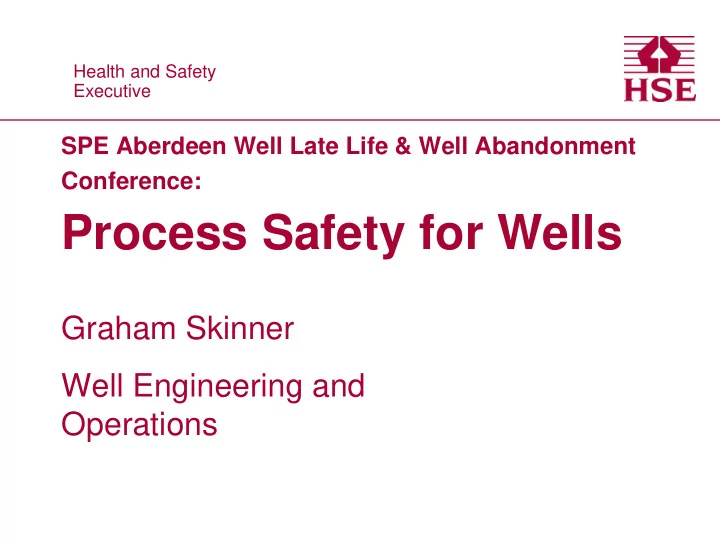

Health and Safety Health and Safety Executive Executive SPE Aberdeen Well Late Life & Well Abandonment Conference: Process Safety for Wells Graham Skinner Well Engineering and Operations
Contents • Inspection findings as leading indicators • Process safety aspects
Inspection Findings 2016 - 2018 • Performance Standards o Installation operator and Well operator PS not aligned o Well components not identified as SECEs such as storm chokes – no verification o ICP Verification activities on wells not occurring for many years o Side outlet valves as single barriers not detailed in PS – (SCP) o Leak rate acceptance criteria do not align to industry benchmarks o 3rd party equipment not addressed in PS o Wells not meeting performance standards; no initiating actions
Inspection Findings 2016 - 2018 • Maintenance o Not managed effectively – overdue wells maintenance not on backlog o Well barrier test records not sufficiently recorded o Well integrity records incomplete and anomaly reporting not occurring as per procedure • Ancillary safety and environmentally critical equipment: o Gauges in unsuitable units or scales o Calibration not occurring – not in maintenance management system o Gauges not checked or failures not recorded o Hose management procedures insufficient or not followed • Suspended platform wells o Integrity monitoring of these wells not defined and insufficient • MAASP
Inspection Findings 2016 - 2018 • Annulus management procedures o Not sufficiently detailed o Not audited or reviewed o Annulus pressures not investigated o SCP not sufficiently monitored o Bleed downs not recorded in WIMS o Bleed down details not recorded i.e. fluids, volumes o Bleed down HP/LP interfaces not sufficiently engineered o Management of change for bleed down rig ups not followed o MAASP not recorded in controlled documents o Current MAASPs not correct in control room or system
Inspection Findings 2016 - 2018 • Cross departmental issues: o Risk assessment o Competence o Well handover documents not completed in sufficient detail o Contingency options for wells risk not tested – i.e. equipment onshore may not be mobilised in time
Inspection Findings 2016 - 2018 • Risk assessment o Wells risk assessments do not stand up to scrutiny o Information carried over to ORA/SCRA inaccurate or incorrect o No tracking or confirmation of mitigating actions in place • Competence o Not covering all positions; system not maintained; 3 rd party personnel not trained; intervention well control certification not present; well integrity training for production team not in place o Production personnel not following written procedures; procedures out of date; wells handovers not occurring • Audit and review o Effectiveness of systems not assured…
Process Safety 1. Leadership and culture 4. Competency • Put process safety on the management agenda • Ensure the continuous development of process and encourage the reporting of “bad news”. safety expertise. • Use every opportunity to discuss and promote • Get expert advice on process safety in the context process safety. of decision-making processes. • Communicate openly about critical aspects of process safety. 2. Risk awareness 5. Action • Make sure that you understand your organisation’s vulnerabilities and risks. • Make sure that bonus schemes don’t encourage • Formulate clear action plans and actively monitor people to put production ahead of process safety. their implementation. • Make sure that risk management activities and corrective measures are carried out promptly. 3. Information • Set up management systems to analyse, prioritise and manage risks. • Make sufficient resources available for improvements and the investigation of near-accidents. The Organisation for Economic Co-operation and Development • Actively share experience and knowledge. (OECD) 5 Pillars of Process Safety Management
Process Safety Experience has shown that most process safety management systems start to deteriorate immediately , or very soon after they have been implemented, unless real efforts are made to maintain their effectiveness. For example, analysis carried out for HSE in 2007 showed that 81% of loss of containment incidents could be traced back to failings in maintaining the requirements of the process safety management system
Process Safety – Ageing Wells • At least 75% of legislative breaches could be avoided by benchmarking against industry standards and guidelines • Active monitoring is not just walking about worksites but is carried out to test the effectiveness of control measures under managers responsibilities • Scrutiny of work carried out by subordinates as a minimum where you have authorising or approving authority • Risk assessments for impaired wells must be facilitated by competent teams, in reasonable time, and effectively monitored and reviewed • Control measures implemented should be records of implementation and then monitored at appropriate frequencies • Cross departmental understanding and communication is critical
Questions
Recommend
More recommend